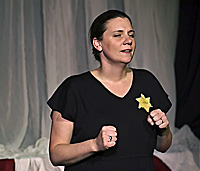When Elizabeth Kenny first read the one-woman play The Last Letter, she was drawn right away to the World War II-era story of a mother writing a letter to her son from a Ukrainian ghetto just days before her death. Kenny, who is now starring in New City Theater’s production of the play, had read extensively about genocides from Rwanda to the Holocaust, but she felt that The Last Letter brought something new to the subject.
“What struck me about this piece was that so much of what I had read was theoretical, about the sociopolitical, economic situations in countries — then you read this letter, and it took it all back from the intellectual. It’s just about what happens to people. This is just what happens,” she said.
The 53-minute play takes the form of a spoken letter from a Jewish woman in the ghetto to her son, written shortly before the ghetto was evacuated and the inhabitants marched to their deaths. The letter is taken directly from the semi-autobiographical novel Life and Faith by the Russian Jewish writer Vasily Grossman, whose mother perished after being forced into a ghetto in the Ukraine.
What’s particularly remarkable to Kenny about the play is the effectiveness of its individual, personal treatment of such charged historic material. Without explicitly stating her feelings about the horrors happening all around her, the speaker, Anna Semyonovna, movingly communicates with the audience. By simply describing what she observes around her every day, she draws the audience into her world, painting a clear picture of life in the ghetto — a life filled with staggering incongruity.
Kenny mentions a moment when Anna relates telling two neighbors that she would soon have to leave her home for the ghetto. Right in front of her, the women began arguing over how they would divide up her furniture — who would get her chairs, her writing desk. Yet when she finally said goodbye, they quickly stopped and, instead, began to cry.
The theme of unrelenting incongruity and the surreal, yet horribly real, aspects of living on the brink of death in one’s own now-unrecognizable town continues throughout the play. These elements are made accessible to the audience through Anna’s own voice, relating the insanity as well as the mundane parts of life.
“She just observes that it is happening, but through this, you get a really deep understanding,” Kenny said.
The Last Letter also brings to light another circumstance perhaps easily forgotten from today’s perspective. Anna Semyonovna, like many Jews in similar circumstances at the time, thought of herself as much more Russian than Jewish. She was educated and well-read, an ophthalmologist and also a French teacher. To find herself treated solely based on her Jewishness, an identity to which she had never given much consideration, was a shock. Yet after living in the ghetto community, with its daily horrors and deprivations somehow leading to a real sense of community and connection between people, her letter reflects her changed sensibilities. Anna finds herself feeling a “maternal tenderness” toward her fellow Jews, strong enough to remind her of her love for her son.
For in the ghetto, Anna relates, there is hope. Even as the ghetto’s inhabitants come to understand that they are headed for imminent death, they seem to feel more and more hope; she finds that here, hope and reason do not go together. And as she writes her letter to her son, who she knows is safe away from the ghetto, she is further comforted.
When New City Theater’s artistic director John Kazanjian first introduced the play to Kenny, she was attracted not just to the spare beauty of the work itself, but also to the subject matter. Traveling with her husband for his work, she had spent time in Rwanda, meeting people, visiting the Kigali Genocide Memorial (“an extraordinary, extraordinary museum,” she said) and experiencing for herself some of the same sense of astonishing incongruity that Anna expresses so effectively in the play.
“In Rwanda, just seeing regular people there living next to each other and using machetes, a farm tool, every day — and this was a major weapon during the genocide there — I thought, “˜How can everybody not be terrified, all the time?’” she said. “And for all I know, maybe they are. But either way, they’re just living their lives.”
Kenny said she hopes that because Anna talks so much about subjective human reactions, audiences will resonate not just with the Holocaust story, but with the generality of the material as it relates to other genocides past and present, addressing the question, “When the world gets overwhelming, how do humans actually behave?”
Letters left unsent
